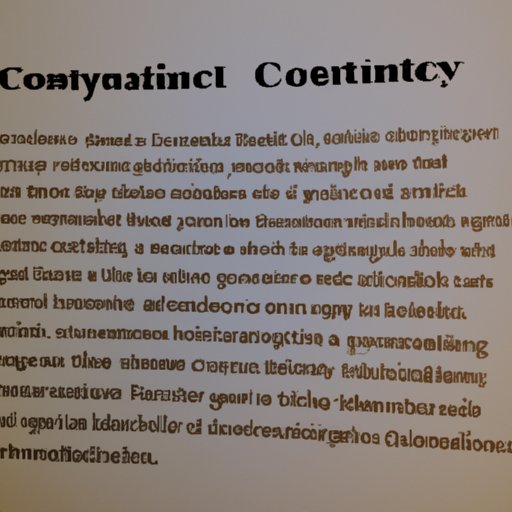Introduction
Understanding cultural differences is an important part of successful communication, especially when it comes to international relations. One concept that can help people better understand cultural differences is the idea of “high context” cultures. High context cultures have specific ways of communicating and interpreting messages that differ from those of low context cultures. In this article, we’ll explore what a high context culture is, its characteristics, and how it affects communication and business practices.
An Overview of High Context Cultures
High context cultures are societies in which the majority of communication is implicit rather than explicit. This type of culture relies heavily on nonverbal cues and the relationships between people to convey meaning and understanding. In contrast, low context cultures are more direct, with less emphasis on personal relationships and more focus on explicit communication.

Exploring the Characteristics of High Context Cultures
High context cultures have several distinct characteristics that set them apart from other types of cultures. Let’s take a closer look at some of these characteristics:
Implicit vs. Explicit Communication
In high context cultures, communication is often implicit, meaning that much of the information is communicated without the use of words. Nonverbal cues such as body language, facial expressions, and tone of voice are used to convey meaning. In contrast, low context cultures rely more heavily on explicit communication, where the message is spelled out in words.
Nonverbal Cues
High context cultures place a great deal of emphasis on nonverbal cues. These cues provide additional information that helps to clarify the message being conveyed. According to research conducted by Hofstede Insights, “In high-context cultures, the meaning of a message is largely determined by the context in which it is delivered, rather than by the words themselves.”
Relationship-Oriented
High context cultures tend to be more relationship-oriented than low context cultures. People in high context cultures rely heavily on personal relationships to build trust and understanding. They may be more hesitant to do business with someone they don’t know or trust.
High Power Distance
High context cultures also tend to have higher power distances, meaning that there is a greater disparity between those in positions of power and those without. This can lead to a hierarchical structure where those in positions of power are respected and those without are expected to obey. As a result, communication between people of different ranks can be more formal and structured.
The Impact of High Context Cultures on Communication
High context cultures can make communication more difficult, especially when communicating across cultures. Since these cultures rely heavily on nonverbal cues and implicit messages, it can be easy to misinterpret or misunderstand what someone is trying to say. Additionally, since communication is often indirect, it can be difficult to get to the point quickly.
How High Context Cultures Influence Business Practices
High context cultures also influence the way business is conducted. Here are a few of the ways that high context cultures can shape business practices:
Emphasis on Relationships
High context cultures place a greater emphasis on developing relationships than low context cultures. This means that building trust is essential before conducting business. As a result, businesses in high context cultures may take longer to develop, as trust must first be established.
Increased Formality
Due to the hierarchical nature of high context cultures, communication between people of different ranks can be more formal. This can make it difficult to establish a rapport with colleagues, as conversations are often more structured.
Long-Term Commitments
High context cultures also tend to favor long-term commitments over short-term ones. This is because trust must be built over time, and businesses in these cultures may be reluctant to enter into short-term agreements.

Strategies for Navigating High Context Cultures
Navigating a high context culture can be challenging, but there are strategies that can help. Here are a few tips for successfully navigating a high context culture:
Respect Local Customs and Traditions
It’s important to respect local customs and traditions when working in a high context culture. This will help to demonstrate your appreciation for the culture and show that you are willing to learn and adapt.
Adapt Your Communication Style
High context cultures require a different communication style than low context cultures. To ensure effective communication, it’s important to be aware of the differences and adjust your communication accordingly.
Learn About the Culture
Finally, it’s important to take the time to learn about the culture you’re working in. Understanding the values, beliefs, and customs of the culture will help you to communicate more effectively and navigate the culture with ease.

Examples of High Context Cultures Around the World
High context cultures can be found all around the world. Here are a few examples of countries with high context cultures:
Japan
Japan is a classic example of a high context culture. The Japanese value politeness and respect, and communication is often indirect. Nonverbal cues and relationships are also highly valued.
China
China is another high context culture. Like Japan, Chinese culture emphasizes politeness and respect. Communication is often indirect, and nonverbal cues are important for conveying meaning.
Korea
Korea is another example of a high context culture. Koreans place a strong emphasis on politeness, respect, and loyalty, and communication is often indirect.
India
India is a high context culture that places a great deal of emphasis on interpersonal relationships. Communication is often indirect, and nonverbal cues are important for conveying meaning.
Conclusion
High context cultures have their own unique ways of communicating and doing business. Understanding the characteristics of high context cultures can help people to better navigate these cultures and avoid misunderstandings. By respecting local customs, adapting your communication style, and taking the time to learn about the culture, you can successfully navigate a high context culture.
(Note: Is this article not meeting your expectations? Do you have knowledge or insights to share? Unlock new opportunities and expand your reach by joining our authors team. Click Registration to join us and share your expertise with our readers.)
